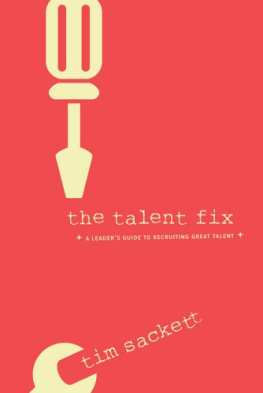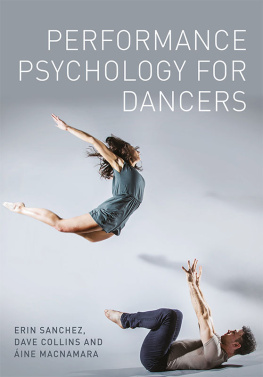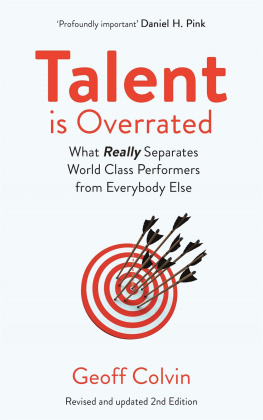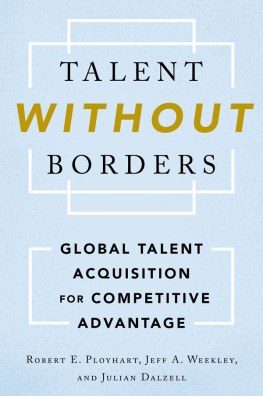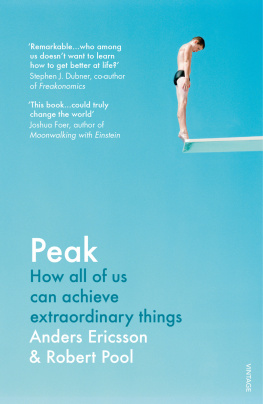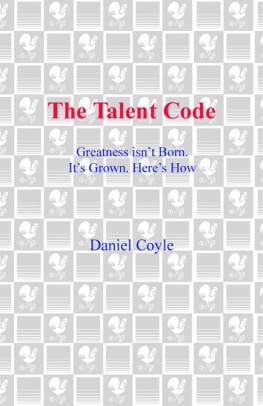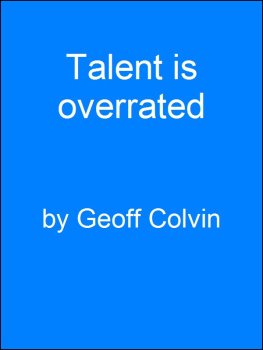Talent Abounds
Talent Abounds
Profiles of Master Teachers and Peak Performers
Robert F. Arnove
First published 2009 by Paradigm Publishers
Published 2016 by Routledge
2 Park Square, Milton Park, Abingdon, Oxon OX14 4RN
711 Third Avenue, New York, NY 10017, USA
Routledge is an imprint of the Taylor & Francis Group, an informa business
Copyright 2009, Taylor & Francis.
All rights reserved. No part of this book may be reprinted or reproduced or utilised in any form or by any electronic, mechanical, or other means, now known or hereafter invented, including photocopying and recording, or in any information storage or retrieval system, without permission in writing from the publishers.
Notice:
Product or corporate names may be trademarks or registered trademarks, and are used only for identification and explanation without intent to infringe.
Library of Congress Cataloging-in-Publication Data
Arnove, Robert F.
Talent abounds: profiles of master teachers and peak performers / Robert F. Arnove.
p. cm.
Includes bibliographical references and index.
ISBN 978-1-59451-633-7 (hardcover: alk. paper)
ISBN 978-1-59451-634-4 (pbk.: alk. paper)
1. Creative ability in adolescence. 2. Teacher-student relationships. 3. Teachers Attitudes. 4. Influence (Psychology) I. Title.
BF724.3.C73A76 2008
153.9dc22
2008027741
ISBN 13: 978-1-59451-633-7 (hbk)
ISBN 13: 978-1-59451-634-4 (pbk)
Designed and typeset in Adobe Caslon by Straight Creek Bookmakers
In memory of Julie and Isadore Arnove
Contents
I'll Take You to the Moon and Beyond:
Peak Performance in Swimming and Diving |
Opening and Extending a Field:
Saxophone and Tuba Virtuosos |
Symphony Conductors: The Legacy
of Leonard Bernstein in Two Profiles |
Over the past thirteen years, numerous individuals have helped in bringing this study to completion. First and foremost, I wish to thank the 150 talented teachers and performers my research assistants and I interviewed. They graciously shared their life stories, many of which remain to be told in subsequent publications.
At each stage of the research and production processinterviewing, transcribing, editingI received invaluable help. Margaret Clements interviewed dozens of Indiana public school educators selected to be Armstrong Teachers in the Indiana University School of Education. Ryohei Matsuda interviewed a sample of the most significant Japanese Living Treasures in the Arts and arranged for me to do so as well. These interviews were videotaped by my daughter, Anna Strout, who also interviewed the artists featured in the chapter on modern dance masters. In addition to work done by Clements, Matsuda, and Strout, the following former students undertook the exacting work of transcribing the interviews: Stephen Franz, Shabana Mir, Allen Kashewa Manjari Singh, and Amber Gallup. As always, my wife Toby Strout proved to be both my most demanding as well as constructive critic. My son, Anthony Arnove, provided valuable advice on writing style and marketing of the book. The editorial and production staff at Paradigm Publishers could not have been more congenial and helpful. They include Martin Hanft (copyediting), Carol Smith (production), Sharon Daughtery (design, artwork, and text of the book cover) as well as Beth Davis (initial editing recommendations) and Ann Hopman (contracts). I am especially grateful to Dean Birkenkamp, Paradigm president and publisher, for his enthusiastic support of the project from its early stages.
Finally, my thanks go to Jeff Alberts and the former Research and University Graduate School (RUGS) of Indiana University for providing initial funding for this study of master teachers and the development of world-class talent.
How can youthful talent become world-class talent? Talent Abounds tells the stories of master teachers and their students who raise performance to peak levels in classical music and conducting, jazz, opera, modern dance, chess, mathematics, swimming and diving, and the culinary arts.
The outstanding teachers, coaches, and peak performers profiled in Talent Abounds are individuals who are internationally recognized as among the very best in their fields. Master teachers attract the most promising young talents and receive constant referrals from widely respected educators, artists, and coaches. Peak performers set world records and win Olympic medals, take top prizes in international music competitions and chess tournaments, receive the most prestigious national awards accorded young and well-established artists, and make seminal contributions to the development of a particular field, whether it be swimming and diving instruction or the range of repertoire for a musical instrument.
In addition to describing the characteristics of master teachers and their prized protgs, as well as the interactions between them, I document how the profiled teachers form part of a continuum of knowledgeable and skillful educators going back for generations. For example, cellist Janos Starker and pianist Gyrgy Sebok represent the culmination of a long line of teachers extending back to Franz Liszt; saxophonist Eugene Rousseau to Marcel Mule and Adolphe Sax, the inventor of the instrument; tubist Harvey Phillips to John Philip Sousa and the Ringling Brothers & Barnum and Bailey Circus Band; jazz composer and instrumentalist David Baker to the origins of jazz in New Orleans and Chicago; symphony conductors Michael Barrett and Michael Morgan to the influence of Leonard Bernstein on generations of musicians; and modern dance choreographers and artistic directors Jennifer Muller, David Parsons, and Sylvia Waters to Isadora Duncan, Martha Graham, and Alvin Ailey.
Themes and Questions
Common themes and questions organize my chapters. The individuals I feature describe their early family experiences and formative years, the progression of teachers and coaches they had, their performance careers, educational philosophy and teaching practices, and their legacies. I explore a number of important questions throughout: Is exceptional talent an innate quality? Even so, does its fulfillment depend on the intervention of expert teachers? How do social class, gender, and ethnicity influence access to instructional and performance opportunities? Can lessons learned in one particular national and cultural context or in one performance field be extended to other societies and fields? To what extent is there a match between a given individual's talents and the state of development of a particular field or domain? How does public policy shape the recognition and development of talent? How can public education nurture the talent of all individuals?
The thirteen substantive chapters group teachers and performers by particular domains: instrumental music (classical, jazz, and traditional), voice (opera), dance (modern), athletics (swimming and diving), chess and mathematics, and the culinary arts. Each chapter portrays clusters of master teachers and performers. Many of the individuals grouped together have been close colleagues who have inspired one another and shared students. I pair teachers and coaches with some of their most successful former students: for example, James "Doc" Counsilman, who pioneered the science of swimming instruction, with Mark Spitz, winner of seven Gold Medals in the 1972 Munich Olympics; diving coach Hobie Billingsley with Mark Lenzi, winner of the Gold Medal on the springboard in the 1992 Barcelona Olympics; violin master teacher Josef Gingold with international virtuosos such as Miriam Fried, Joshua Bell, and Corey Cerovsek; opera diva Virginia Zeani with renowned sopranos Sylvia McNair and Angela Brown.



